-
Paper Information
- Next Paper
- Previous Paper
- Paper Submission
-
Journal Information
- About This Journal
- Editorial Board
- Current Issue
- Archive
- Author Guidelines
- Contact Us
International Journal of Metallurgical Engineering
p-ISSN: 2167-700X e-ISSN: 2167-7018
2012; 1(5): 83-87
doi: 10.5923/j.ijmee.20120105.03
Bacterial Reduction of Hexavalent Chromium from Contaminated Overburden Soil
B. Dhal 1, 2, N. N. Das 2, H. N. Thatoi 3, B. D. Pandey 1
1CSIR-National Metallurgical Laboratory, Jamshedpur, 831007, India
2Dept. of Chemistry, North Orissa University, Takatapur, Baripada, 757003, India
3Dept. of Biotechnology, College of Engineering & Technology, Bhubaneswar, 751 014, India
Correspondence to: B. D. Pandey , CSIR-National Metallurgical Laboratory, Jamshedpur, 831007, India.
| Email: |  |
Copyright © 2012 Scientific & Academic Publishing. All Rights Reserved.
This study was focused for the bioreduction of Cr(VI) from chromite mine overburden soil using a highly tolerant Bacillus sp. isolated from chromite mine soil. Under the optimized conditions of pH ~7.0, Bacillus sp. (4.05 x 107 cell mL-1) reduced more than 98% of Cr(VI) from the soil sample in 16 h at 60% pulp density(PD). The exponential rate equation yielded rate constants in the range 4.92310-1 h-1 – 2.14110-1 h-1 for 20% and 60% PD respectively, which decreased with increase in Cr(VI) concentration. The bio-reduction was also carried out in absence of media at the higher pulp density (60%) as used in the chromite ore beneficiation plant. After bio-reduction the samples were characterized using FT-IR for the leaching of other valuable metals using bio-organic acids.
Keywords: Chromite Mine Overburden, Bacillus sp, Cr(VI)
Cite this paper: B. Dhal , N. N. Das , H. N. Thatoi , B. D. Pandey , "Bacterial Reduction of Hexavalent Chromium from Contaminated Overburden Soil", International Journal of Metallurgical Engineering, Vol. 1 No. 5, 2012, pp. 83-87. doi: 10.5923/j.ijmee.20120105.03.
Article Outline
1. Introduction
- India is the second largest producer of chromites in the world. Open cast chromite mining activity leads to various environmental problems due to the release of hexavalent chromium (VI). Contamination of soil and water in chromite mining areas is a widespread and serious problem. Orissa state accounts for 98% of the total chromite reserve of the country and the South Kaliapani chromite mine area of Orissa contributes about 97% of the total chromite reserve of the state[1-4]. As a result of growing open cast mining activities in the area, the environment is under threat[3]. The element chromium exists in two stable states, i.e., hexavalent chromium Cr(VI) and trivalent chromium Cr(III). Cr(VI) is the most toxic form of chromium[4] and is largely produced from anthropogenic sources, mining, and various industrial activities. In the hexavalent state, chromium exists as oxospecies such as CrO3 and CrO42- that are strongly oxidizing. Hexavalent chromium may exist in aquatic media as water soluble complex anions and may persist in water. Hexavalent chromium is a strong oxidizing agent and may react with organic matter or other reducing agents to form trivalent chromium[5]. Chromium toxicity results in the inhibition of plant growth and hazard to the living organisms. The objectives of this study were mainly to investigate the extent of chromium contamination by mine overburden soil in the study area viz. Kaliapani chromite mine, India and bioremediation of hexavalent chromium using native microbial isolates.
2. Materials and Methods
2.1. Collection and Characterization of Soil Samples
- Overburden soil samples were collected in sterile glass bottles from Orissa Mining Corporation (OMC), South- Kaliapani chromie mines of Orissa, India with varying composition, storage time and microbial differences. The soil samples (15-20 cm depth) were collected and stored at 4℃., soil samples were dried and ground to powder for chemical analyses and phase identification. The chemical analyses of soils (before and after reduction) were carried out by conventional method while the mineral phases of chromite overburden were identified from the powder X-ray diffraction (PXRD) patterns (Siemens D500) using CuKα radiation at a scanning speed of 2(2θ)/min. The soil and treated samples were analysed for functional groups using FT-IR spectra.
2.2. Revitalization and Adaptation of isolated Bacillus Species
- Previously isolated and hexavalent chromium reducing strain viz., CSB-4 identified as Bacillus sp.[5] was sub- cultured and adapted using real chromium(VI) contaminated overburden soil of OMC, South-Kaliapani chromite mines. Adaptation has been carried out using Luria broth media (containing g L−1, 10 tryptone, 5 yeast extract, 10 NaCl) containing different pulp densities (5 - 60%) of contaminated soil. The flasks were incubated at pH 7.0 and 35℃ while shaking at 100 rpm for five days. The pH was maintained to 7.0 on daily basis and cell count was monitored to check the growth of the bacteria.
2.3. Effect of pH, Nutrient, Temperature, and Pulp Density on Bacterial Reduction
- The bacterial reduction of Cr(VI) was studied in the pH range 2.0 - 9.0 while inoculating 1mL of pre-grown adapted culture in different test flasks (adjusted to the desired pH) containing 10% pulp density (PD) under incubator at 35℃ with a shaking speed of 100 rpm. The effect of temperature was studied in the range 25 - 45℃. The composition of LB medium was also varied (tryptone, sucrose, beef extract and NaCl constituents) at different pulp densities (20 - 60%) to examine the Cr(VI) reduction from the contaminated soil. The data from duplicate sets of each experiment were collected with a variation within ±2% and were averaged to compute the extent of reduction.
2.4. Chemical Analysis
- Hexavalent chromium in the overburden soil was leached rigorously with pure distilled water (solids to water mixture ratio 1:10) for 6h using horizontal shaking at rated speed of 100 rpm[5]. Leached water was separated by filtration using Whatman 42 filter paper and filtrate containing almost 99% of total dissolvable Cr(VI) was estimated bydiphenylcarbazide method[6,7]. A certain volume of supernatant was taken with 2 mL of 6 N H2SO4 and 1 mL of 1,5-diphenyl carbazide (Hi-Media) (0.25%). After 10 min of incubation at room temperature, the absorbance of the resultant solution was measured at 540 nm by UV spectrophotometer against a known standard. All the experimental analysis was carried out using above method.
3. Results and Discussion
- As stated above, the samples were collected and stored for their chemical composition and microbial isolation. The Bacillus sp. which was isolated from the Cr(VI) contaminated soil of 5-6 year old chromite mine overburden dump has a good potential for hexavalent chromium tolerance while growing in the same soil. The bacterial strain was repeatedly sub-cultured for several times and maintained in Luria broth inoculating with contaminated soil. Due to its high tolerance and growth, this strain was further chosen for chromium(VI) reduction from overburden soil[8-11].The soil samples were characterized for their chemical composition and metal content by X-ray fluorescence (XRF make Phillips Axion). The XRD phase identification of one of the samples viz., OBS-4 (5-10 year old overburden dump) shows predominantly the presence of goethite phase along with minor quantity of hematite, chromite, and quartz. Small peaks of clay minerals possibly nontronite ((Ca,Mg)0.5Fe2(Si, Al)4O10(OH)2.xH2O) were also observed. The sample with these phases was consistent with its chemical analyses (Cr, 3.43; Fe, 58.624; Al, 4.42; Si, 2.69; Ni, 1.244; Mn, 0.404; Co, 0.177; Ti, 0.116; Mg, 0.154; wt% as the major and Ca, 0.018; Na 0.0659; K, 0.07; V, 0.015; Zn, 0.056; P, 0.012 wt% as the minor constituents). The overburden dump soil contains several metals including chromium as Cr(III) and Cr(VI).
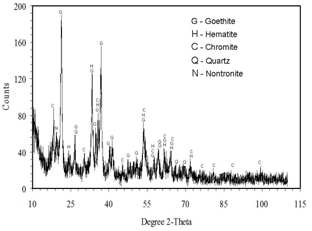 | Figure 1. XRD of COS – 4 containing metallic phases |
3.1. Effect of Working Parameters on Bioreduction of Cr(VI) of Soil Sample
3.1.1. Effect of pH
- The reduction of Cr(VI) from the soil sample (OBS-4) was studied (Fig 2) in different pH range (2.0–9.0). It may be seen that the reduction increases with increase in pH up to 7.0 with 98% chromium(VI) reduction in 6 h, and then decreases on raising the pH[10,11]. The inhibitory effect below pH 5.0 is presumably due to the decrease in cell growth as the observed optimum pH value for cell growth is 6.0–7.0 in the same nutrient medium without Cr(VI). Consequently, further reduction experiments were carried out at pH 7.0.
3.1.2. Effect of Nutrient
- As the process is aimed for pilot scale operation, the nutrient media is very important for economic point of view. The experiments were carried out with individual component of the nutrient of Luria broth, sucrose (10 g L-1) and beef extract (5 g L-1), along with the microbe during inoculation with the contaminated soil. The results showed that the most important nutrient was sucrose as 99% of Cr(VI) was reduced in 12h from 500 mg Cr(VI)/kg sample, which was the same as that of LB medium (Fig 3) at 60% pulp density. The lowest chromium(VI) reduction was found in only NaCl containing flask (~ 18%), due to the absence of carbon source to exhilarate the growth of the bacterial strain. It may be mentioned that if cell growth is improper, the reduction of chromium(VI) is adversely affected[10,11].
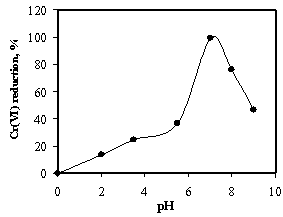 | Figure 2. Effect of pH on Cr(VI) reduction from soil (35oC, 500mg Cr(VI)kg-1 soil, size <100 μm, 60%PD, time 12h) |
3.1.3. Effect of Temperature
- In the temperature range studied (25–45℃), the extent of Cr(VI) reduction increased with increase in temperature from 25 to 35℃ (Fig 4). About 93% Cr(VI) reduction was observed at 35℃(308 K) in comparison with only 14% reduction at 25℃(298 K) in 12 h. Okeke et al.[12] also reported a similar optimal temperature for growth and Cr(VI) reduction with Bacillus sp. isolated from soil enrichment cultures. At 45℃(318 K), 62% of Cr(VI) reduction was achieved in 12 h of incubation. At higher temperature the reduction was lower as compared to that of 35℃ which may be due to the improper cell growth at higher temperature. The growth temperature is thus optimized to be 35℃ for Bacillus sp. while growing in LB medium.
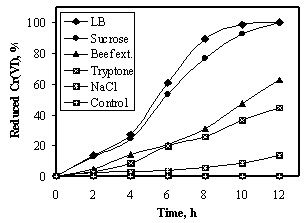 | Figure 3. Effect of nutrient on Cr(VI) reduction from soil (35℃, 500mg Cr(VI)kg-1 soil, size <100 μm, 60%PD, time 12 h) |
3.1.4. Effect of initial Cr(VI) concentration
- The reduction of Cr(VI) from the overburden soil was further carried out with the optimized parameters established above at different pulp density and using different concentrations of Cr(VI) and results are presented in Fig 5. As can be seen reduction was dependent on Cr(VI) concentration. Reduction of Cr(VI) was relatively high in case of 20 and 40% PD and complete reduction (≥ 98%) was observed in 12 and 14h, respectively. The reduction was very fast where the Cr(VI) content was low of 100 and 200 mg L-1 at the pulp density of 20 and 40% respectively[13]. But in the case of 60% PD, it consumed two hours extra as compared to that of 40% PD i.e. 16h for complete reduction due to high concentration of chromium (300 mg L-1) and its relative toxicity on the bacterial cells.
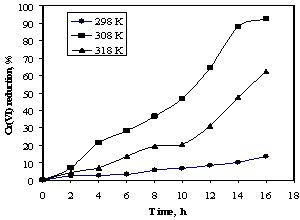 | Figure 4. Effect of temperature on chromium (VI) reduction |
 | (1) |
 | (2) |
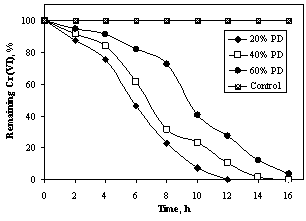 | Figure 5. Effect of different pulp density on reduction of Cr(VI) (Temp 35℃, pH ~ 7) |
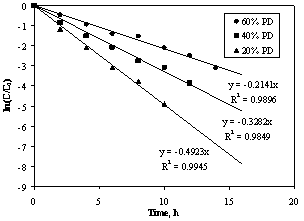 | Figure 6. Rate of Cr(VI) reduction for different Cr(VI) levels at 35℃ & 7.0 pH |
3.2. Characterization of bio-reduced Sample
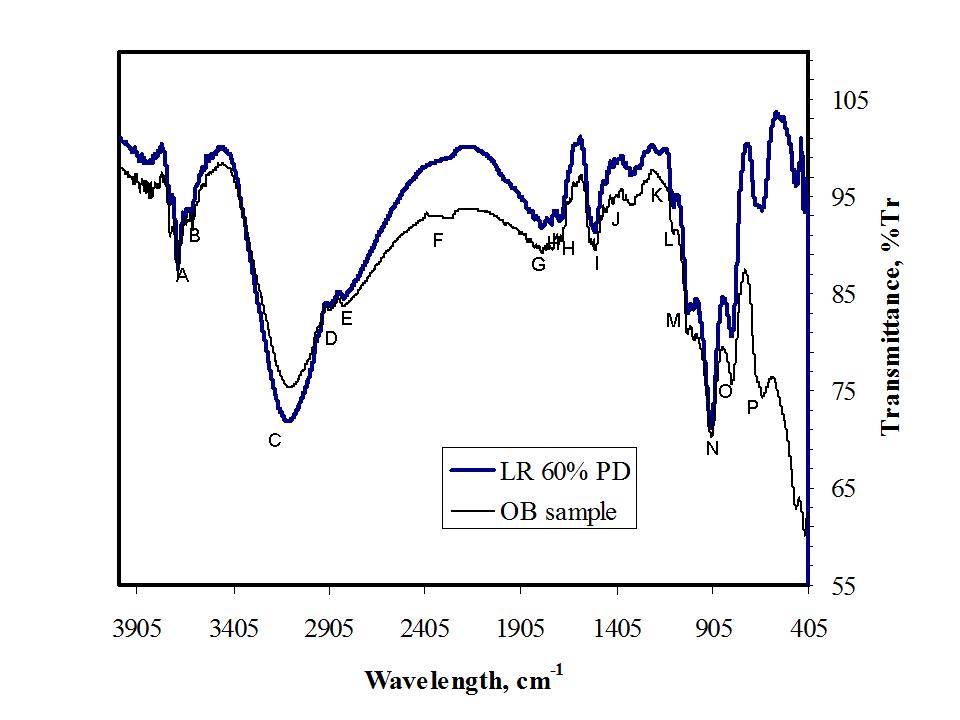 | Figure 7. IR spectrum of COS – 4 before and after Cr(VI) reduction |
|
4. Conclusions
- The Bacillus sp. isolated from the overburden soil sample is found to be fairly effective for reducing chromium(VI) from the chromium contaminated overburden soils. At optimal pH 7.0 and temperature 35℃, ~ 98% of[60%, PD; 500 mg Cr(VI) kg-1 of soil ~ 300 mg Cr(VI) L-1] chromium (VI) is reduced in about 16 h of incubation. The rate of reduction decreases with time, especially at the higher pulp density with higher initial Cr(VI) concentration due to Cr(VI) toxicity on the bacterial cell. Fitting of time course reduction data to the exponential rate equation (C/C0=ae-kt) yields rate constants in the range 4.92310-1 h-1 - 2.14110-1 h-1 for 20% and 60% PD respectively. This strain can further be explored for reduction of Cr(VI) of chromite concentrates as COB plant operations are generally carried out at a 60% pulp density with a much lower chromium(VI) concentration. The adaptation of Bacillus sp. is going on for large scale experimental studies. The reduction of hexavalent chromium from the contaminated overburden soil has also been planned using different nutrient deficient condition for the large scale experiments. The carbon source, sucrose has same reducing ability as that of the supplied Luria broth. After chromium reduction the samples can be characterized for mobility of the metals which includes immobilization or leaching of metals with fungal species and thereby ensuring safe dumping.
ACKNOWLEDGEMENTS
- The authors are thankful to the Director, National Metallurgical Laboratory, Jamshedpur, India for his permission to publish the paper. One of the authors (B. Dhal) is grateful to Council of Scientific & Industrial Research for awarding Senior Research Fellowship.
 Abstract
Abstract Reference
Reference Full-Text PDF
Full-Text PDF Full-Text HTML
Full-Text HTML